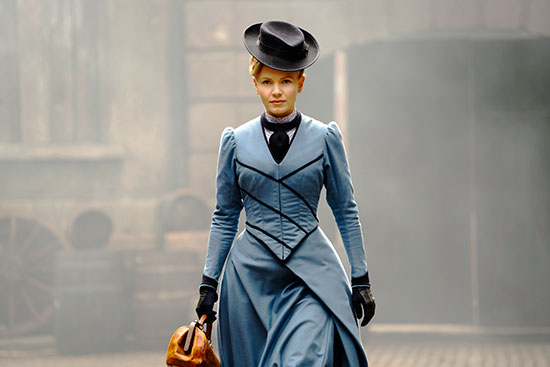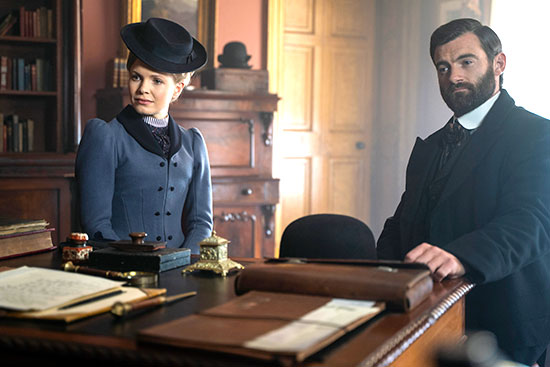Last Updated on June 7, 2023
It’s a truth universally acknowledged: one of the best parts of period dramas is the costuming. And while Rachael New’s “Miss Scarlet and The Duke” had almost everything we could ask for — mystery, tension, romance, humor — its costumes were definitely a stand-out part of the show.

To help keep this site running: Willow and Thatch may receive a commission when you click on any of the links on our site and make a purchase after doing so.
I mean, they had pockets.
The costume designer for the show, Leonie Prendergast, has a rich resume. In addition to her work on “Miss Scarlet and The Duke,” she has also worked on shows as diverse as “Moone Boy,” “Ripper Street,” and “The Turning,” as well as 2020’s fantasy-horror film, “Gretel & Hansel.”
Her costumes are always detailed, and never disappoint — something that we particularly noted in the anachronistic “Miss Scarlet And The Duke.”
Naturally, we couldn’t resist taking this opportunity to dig deeper into just how meticulous and clever Prendergast is in her work. And there’s no better way to do so than by taking a deep dive into Eliza Scarlet’s iconic blue dress.
Let’s start with the most obvious element of the costume: the color. Sky blue with navy piping is a great color selection for summer-complected actress Kate Phillips, but it also fits in with the fashion of the period. Sky blues were considered the ‘perfect contrast’ to a blonde’s orange undertones.
The colors are also a subtle nod to Eliza’s inner state; blue is the color of cool and calm, dignity and poise, while navy symbolizes sadness and mystery. With the death of her father in episode one, and her growing confidence as an inspector, these colors speak to Eliza’s past as well as her future.
In an interview with MASTERPIECE, Prendergast also said that the blue was intended to mimic a police uniform, tying into the adage that one should “dress for the job you want.”
The cut of the dress is what is called a “walking suit” — though walking suits often have shorter skirts than we see on Eliza. But for the most part, the silhouette of her dress fits the fashion of the time: a long-boned bodice, tight sleeve and high neck. However, the details of the piece are where Prendergast got to play around a little bit.

Eliza Scarlet is ahead of her time — and fact of which we are reminded throughout the series. But it’s not just her actions and voice that tell us just how forward-thinking Eliza is; her wardrobe tells us, too. While the series is set in 1882, Miss Scarlet’s dress contains quite a few elements that wouldn’t appear until the next decade, including masculine details, asymmetry, and, yes, those aforementioned pockets.
The late 1890’s saw masculine details bleeding through to women’s fashion, an occurrence that costumers attribute to the growing popularity of sports. We see this feature most strongly in Eliza’s ascot and the high collar of the shirt she wears beneath her bodice.
Her hat, while also falling into this category, is also anachronistic in its own special way. While women of the era did favor the style of men’s hats, they were almost exclusively sized down and highly decorated.
Eliza’s hat eschews all decoration, and is almost full size — indicators of her no-nonsense attitude and background as a girl raised by her father. What’s more, the hat appears to be a modified fedora, mimicking the look of the 1940s gumshoes we’re most used to seeing in mystery series.
Eliza’s bodice is another element that indicates how she would like to be perceived. While asymmetry was often seen in Victorian fashion — most popularly in the form of fishtail skirts — the long side-tail of her bodice was essentially unheard of. This detail cues Eliza’s nature of “standing out from the crowd,” as Prendergast says.
And finally — the pockets! While pockets, in one form or another, have been part of women’s fashion from as early as the 17th century, the Victorian Era saw them predominantly as an accessory for children or working-class women.
Prendergast first came up with the idea to equip Eliza with pockets as a way for her to secret away props, or the tools of her trade. But they also tie in neatly with Eliza’s close relationship to Ivy, her housekeeper. Ivy may be a working class woman, but she serves as Eliza’s mother-figure; add to that the fact that Eliza so earnestly wants to create a career for herself, and the pockets in her dress become significantly less anachronistic.
The iconic blue walking suit that Eliza wears throughout the show is only one of many gorgeous outfits that Prendergast created. Each one offers its own unique clue into how Eliza presents herself to the world, how she is feeling, and what she hopes for.
It’s up to us — through Predergast’s clever presentation — to learn how to put those clues together.
“Miss Scarlet and the Duke” is AVAILABLE to STREAM
Andrea Wolanin is a content creator and host for WGBH by day and a writer/director of weird films by moonlight. While she discovered British Comedy as a guttersnipe at her mother’s knee, it wasn’t until her grandmother introduced her to “Father Brown” that she realized her love for the mysterious and dramatic side of things.
If you enjoyed this post, wander over to The Period Films List. Also see Were There Really Victorian Era Female Detectives, and MASTERPIECE at 50: What’s Next.


Leslie
January 17, 2023 at 11:39 pm (1 year ago)I believe women’s dresses and skirts had pockets by 1860. Why did designer say pockets weren’t common in the late 1800s?
Mr.Kelly A. Forsythe
August 31, 2021 at 7:56 pm (3 years ago)I really, really love the black hat with the blue dress. The short crown on this hat along with the trim around its brim ! Absolutely fabulous! Is this hat/ the like, available for sale ANY where?
Please advise,
Truly, a gracious thank you.
Larry
April 29, 2021 at 4:19 pm (3 years ago)How much did the blue dress cost and how long did it take to make ?
Leonie
March 31, 2021 at 4:41 pm (3 years ago)Dear Andrea,
Thank you for your very eloquent, insightful and thoughtful review. It truly means so much ❤️X
Willow and Thatch
March 31, 2021 at 6:30 pm (3 years ago)It’s so nice to have you here, Leonie!
Andrea
March 31, 2021 at 7:52 pm (3 years ago)Thank you so much, Leonie! I love digging into costumes and the theory behind them – it was truly a pleasure to be able to uncover some of the mysteries behind your work! <3
Beth
March 17, 2021 at 3:50 pm (3 years ago)l love period dramas for the costumes as well as the sets’ accuracy. Ms. Prendergast’s costume designs in Miss Scarlet and the Duke are wonderful. My favorite of Eliza’s dresses is the burgundy one. I’m assuming this is her most “flirtatious” dress. I hope Eliza will have a few more costumes to show us in Season 2. 🙂
Jennifer Bruce
March 17, 2021 at 12:07 pm (3 years ago)I watch Miss Scarlett and the Duke; All Creatures, Midsomer murders, Morse, Lewis Endeavour etc. Excellent quality of writing and acting.
Karen Lucchesi
March 16, 2021 at 1:42 pm (3 years ago)Love Masterpiece. Absolutely love All Creatures Great and Small! Do not want it to end. The cast, story line and scenery are wonderful. Just wish they had more. These presentations are just so fabulous…and the costumes outstanding. I do support these programs the best I can.
Ath El
March 15, 2021 at 7:23 pm (3 years ago)My wife and I have noted that Miss Scarlett seems to only have 3 or 4 dresses. Is it because she has little money and can’t afford much, or was it normal to have so few?
Susan
March 17, 2021 at 12:42 am (3 years ago)I believe this is correct. Although the Scarlett family was above working class, they would not have been a part of the aristocracy, As such, a young woman would not have an elaborate wardrobe. A walking suit such as the light blue one would have served for one or two years. Three or four day gowns would have been in line with the families social standing. When she was at home, she would have been dressed differently than how she is dressed in the series in a dressing gown or tea gown.
Peggy
March 15, 2021 at 4:01 pm (3 years ago)Love PBS movies
V White
March 16, 2021 at 7:12 pm (3 years ago)I sincerely look forward to anything Masterpiece presents. The quality is outstanding. The stories engaging. I have shared with friends that when watching British television you become involved, when watching American television, you just watch!
Juliette Andrews
March 15, 2021 at 3:46 pm (3 years ago)I ama a Fan of masterpiece I have seen most of their films
I also love Doc Martin, fr. Brown miss Fisher’s mysteries Midsummer’s mysteries etc.. . I only wish that I could afford Britbox.